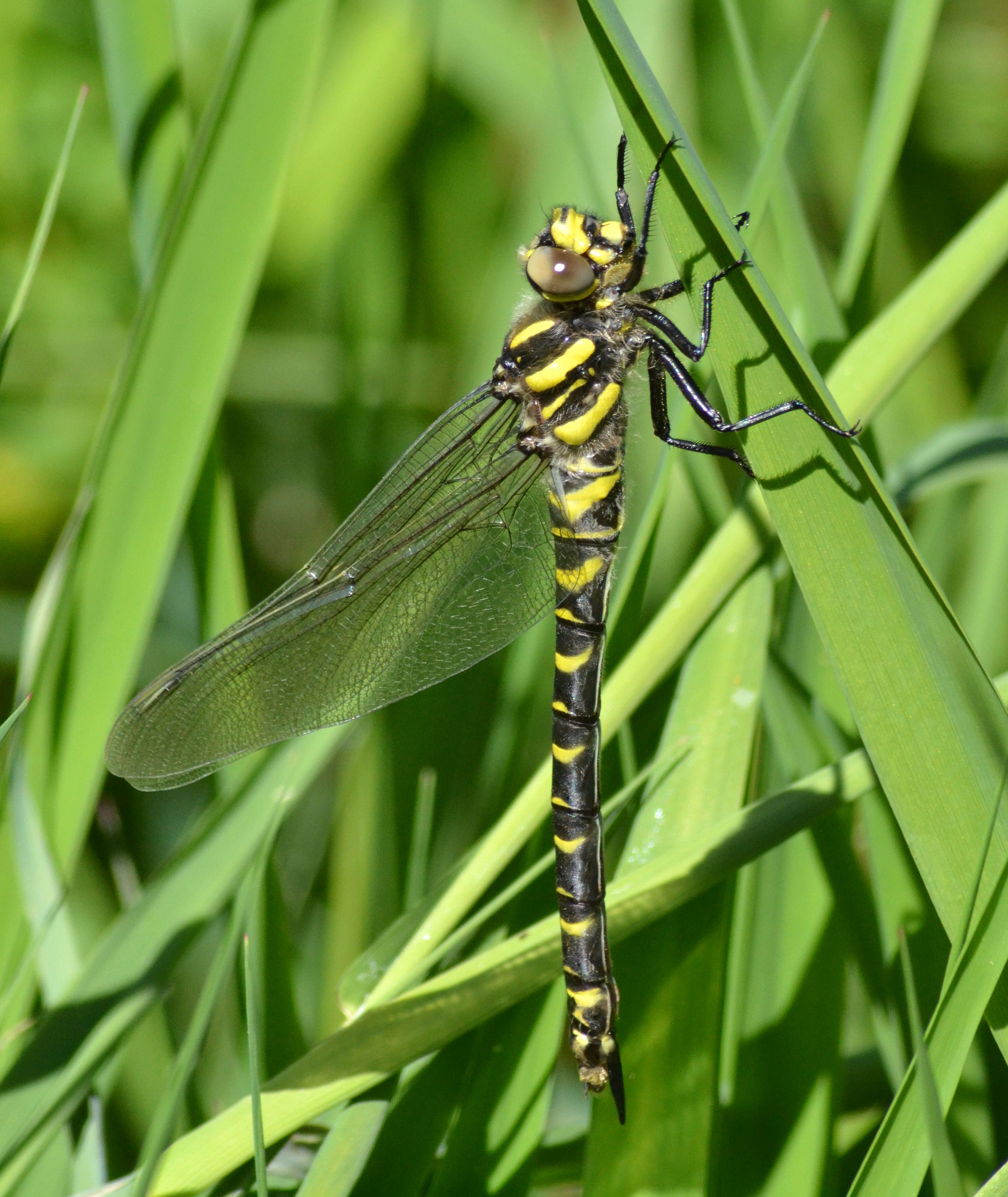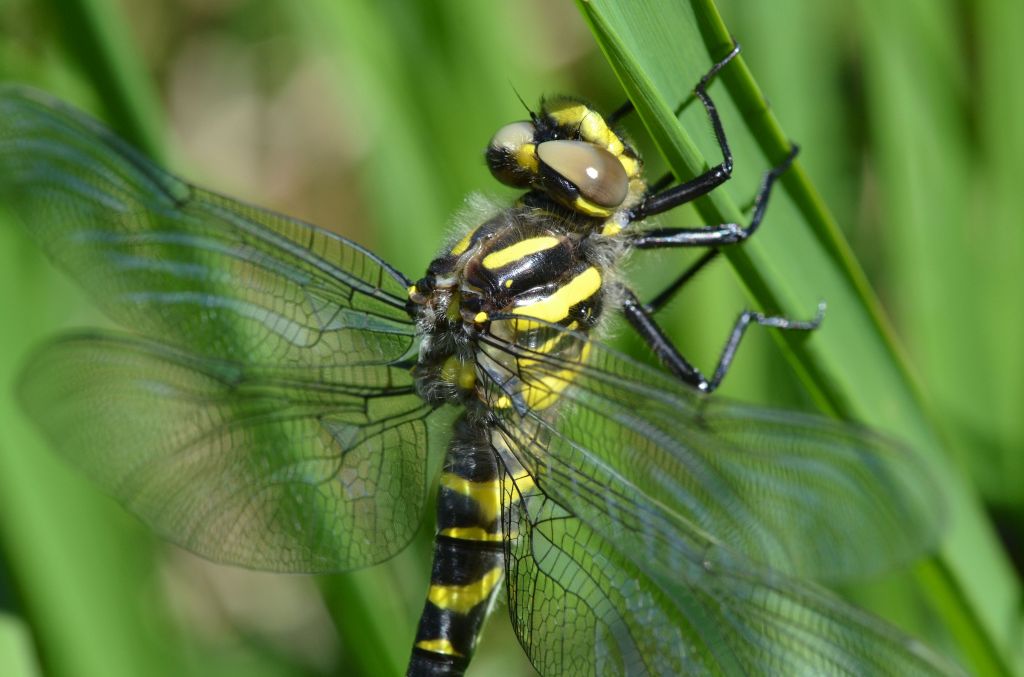The so often cold and wet spring of 2021 has been an undeniably dismal early season for both butterflies and odonata, but today was forecast at last to be consistently sunny. Hence I headed off south to attempt more from a lingering 2020/21 national agenda. It is an idiosyncratic dragonfly season indeed when Common Goldenring is encountered ahead of either Hairy Hawker or Four-spotted Chaser.
Dorset Wildlife Trust’s Troublefield reserve (see here) is a remnant of unimproved wet pasture grassland beside the Moors River, a tributary of the River Stour that it joins a mile to the south. The Moors River is unusual in rising on chalk downland but being fed further downstream by run-off from acidic heath, and so supports a varied aquatic and wetland flora and fauna. The water meadows remain damp throughout the year and are flooded for most of the winter. In summer they are managed by light cattle grazing to keep the vegetation under control.
The reserve’s habitat of flowing and standing water alongside rushy grassland, trees and scrub creates conditions to suit a diverse range of insects. Up to 28 species of odonata have been recorded here including Great Britain’s last known Orange-spotted Emerald. It is very much an off-piste ambience at Troublefield (pictured below), with wellington boots essential barring a full set of angling waterproofs and a hiking pole advisable.
The entrance is accessed along a track signed 124 Matchams Lane in the village of Hurn (SZ 127976 – BH23 6AP). I arrived there just after midday. Another enthusiast who was about to leave said the main odo activity for him had been damselflies and he had not found either of my targets, Hairy Hawker and Blue (or Scarce) Chaser. That was indeed my own experience as I made two laps of the southern meadow, the outside edges of which had been cut to allow access. Both Demoiselles were present in places and lots of Large Red Damselfly, many of the latter in tandem. Then along the Moors River side, on looking down I beheld this (below).


Perched in the grass was a newly emerged female Common Goldenring. As I watched her wings gracefully opened proclaiming the nascent creature in all her latent elegance as she hung herself out to dry before me. What a stunner! I cannot ask often enough whether there is anything more exquisite in the natural world than a dragonfly, especially in such a pristine and virginal state as I was now witnessing. So birders, if you might have read thus far there is more of the same to come. This is not “Hobby food” and in my view certainly not more boring than plumage topography or camera settings.
Once again I was completely alone with the entity in question, which though not a preferred state for me may be a means to enjoy such communion and gain pictorial records of desired quality. Experiencing new odo colour forms is a real motivation now in order to evolve year on year. As in images of different species seen online the stand-out difference here was the eyes, that in Goldenrings meet in a point at the centre of the head.

Just look at those gorgeous and beguiling, milky coffee-coloured orbs (above) – Cappuccino even complete with the froth. In adults the eyes are bright green in males, less so in females. But this teneral also seemed to exude an all-round subtlety I had not discerned previously in such a bold looking dragonfly, by virtue of her paler lemon yellow toning. I sat down with this beautiful lady for some time, enjoying her complete trust and fellowship. But I feared for her in such an exposed pose lest she be snatched by a passing Corvid, or perhaps to some birders’ liking a Hobby. Fortunately there were none of either about.



Eventually my charge’s wings began to quiver and shimmer, gaining momentum as I watched on, then off she flew high towards the canopy on the far side of the meadow. “Rise today and change this world” is an analogy I cannot use too much and seems appropriate once more. Late May is indeed the start of Common Goldenring’s flight season, so something at least was now on time in the insect world for this particular spring.
My day had begun in the East Inclosures of the New Forest, Hants where I headed for my now annual Pearl-bordered Fritillary fix. There have been only sporadic opportunities to observe the early season icon in 2021, with the most reported locations as usual being the popular circuses of Rewell Wood, Sussex and Bentley Wood, Hants. I much prefer it here where I can wander at will without being accosted or jostled by social media-enthused crowds.


I had first visited this year on 7th May with a companion who soon becomes impatient If I cannot make quick butterfly connects. Walking out from the Standing Hat car park (SU314036) there were no Pearls along the usual ride through Pignal Inclosure, beside which the habitat seemed very dry and devoid of wild flowers. The habitat also bore ample testimony to the human footfall it must have endured through the Covid year of 2020/21. What the effect of such visitor pressure must have been on wild flower generation was all too clear.
We went as far as Parkhill Inclosure that had been the most productive spot on my 2019 visit though less so in 2020. But there were still no butterflies or the wild Bugle plants that attract them. At that point my colleague refused to go further, saying the exercise was a waste of time. Fuelled by pessimism such as the experience induced I feared whether this New Forest locality was still being managed sympathetically for PBF by Forestry England and whether the butterflies might be in serious decline. But five days later on 12th a positive sighting came from the nearby Frowhawk Ride (SU317052) and I at once resolved to revisit what is a favourite site alone and do the job properly.


Such an opportunity arose today (there it is again!) and I was not to be disappointed. Arriving some time after 9am I came across four Pearls along the ride through Pignal Inclosure and 13 more as the day warmed up in or around Parkhill Inclosure. This was much more like it! Then I rambled on further, recognising suitable PBF habitat along other rides and counting up to 37 individuals, though there were clearly many more to be found had I searched harder. In the process and directed by locals I reached for a first time Ramnor Inclosure, where the habitat looked the best managed for PBF of all. But I could not locate the Frowhawk Ride – guidance in comments please anyone?
Though Bugle remained in short supply the butterflies were availing themselves of a number of other wild plants. I have many PBF images already in my collection. This post presents the best new additions from today, and it is always a privilege to capture any insect pictorially on Euphorbia (below, right).


So I am very pleased to have found the New Forest Pearl-bordered Fritillary population to be still healthy and thriving in suitably managed habitat. I love this place for the relaxation and tranquillity it affords. Butterflying for me is not about pressure, competition and adrenalin but escapism through unhurried fieldwork in beautiful wild places. The East Inclosures (see here) had once again supported that criterion as well as anywhere I know.







